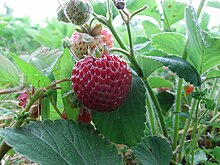Hex-3-enyl acetate
| Structural formula | ||||||||||||||||
|---|---|---|---|---|---|---|---|---|---|---|---|---|---|---|---|---|

|
||||||||||||||||
| Structural formula of cis -hex-3-ene acetate | ||||||||||||||||
| General | ||||||||||||||||
| Surname | Hex-3-enyl acetate | |||||||||||||||
| other names |
|
|||||||||||||||
| Molecular formula | C 8 H 14 O 2 | |||||||||||||||
| Brief description |
colorless to yellowish liquid with a fruity odor |
|||||||||||||||
| External identifiers / databases | ||||||||||||||||
|
||||||||||||||||
| properties | ||||||||||||||||
| Molar mass | 142.19 g mol −1 | |||||||||||||||
| Physical state |
liquid |
|||||||||||||||
| density |
0.90 g cm −3 (25 ° C) |
|||||||||||||||
| boiling point | ||||||||||||||||
| solubility |
|
|||||||||||||||
| safety instructions | ||||||||||||||||
|
||||||||||||||||
| Toxicological data | ||||||||||||||||
| As far as possible and customary, SI units are used. Unless otherwise noted, the data given apply to standard conditions . | ||||||||||||||||
Acetic acid hex-3-enyl ester , also 3-hexenyl acetate , is a chemical compound from the group of unsaturated carboxylic acid esters and green leaf fragrances .
Occurrence, properties and use
The ester is found in the leaves and berries of many plants (such as strawberry, apple, apricot, tea leaves, and tomato). The substance is released from plants - in addition to cis -3-hexenol - after tissue damage to kill fungi ( fungicide ) and bacteria ( bactericide ) and as a defense against herbivorous animals, mostly insects.
The colorless liquid, which smells strongly of green fruits, is used in industry - often mixed with the "leaf alcohol" cis -3-hexenol - as a flavor and fragrance . The odor threshold in humans is 7.8 μg / kg. The flavor is industrially produced by the acid-catalyzed esterification of acetic acid and cis -3-hexenol.
safety instructions
The toxicity of acetic acid hex-3-ene ester in animal experiments with rabbits and rats was low: the LD 50 values dermal and oral were> 5 g / kg body weight. In the US , the FEMA P ADI is 2.9 mg / day.
Individual evidence
- ↑ a b c d e f Entry on (Z) -Hex-3-enyl acetate in the GESTIS substance database of the IFA , accessed on January 10, 2017(JavaScript required) .
- ↑ a b c d George A. Burdock: Fenaroli's handbook of flavor ingredients. 5th edition, CRC Press, 2005, ISBN 978-0-8493-3034-6 , p. 800.
- ↑ a b c Food and Cosmetics Toxicology , Vol. 13, 1975, p. 454.
- ↑ a b c Entry on hex-3-enyl acetate in the ChemIDplus database of the United States National Library of Medicine (NLM) .
- ↑ Lebensmittel-Lexikon, Waldemar Ternes, ISBN 978-3-89947-165-6 ( limited preview in the Google book search).
- ↑ Horst Surburg, Johannes Panten: Common fragrance and flavor materials: preparation, properties and uses. 5th edition, Wiley-VCH, 2006, ISBN 978-3-527-31315-0 , p. 21.
- ↑ John D'Auria: How the formation of green leaf fragrances is controlled. (PDF; 9.9 MB) Max Planck Institute for Chemical Ecology , Jena.
- ↑ Hans-Dieter Belitz: Textbook of food chemistry. Springer-Verlag, 2008, ISBN 978-3-540-73202-0 , p. 388 ( limited preview in the Google book search).

